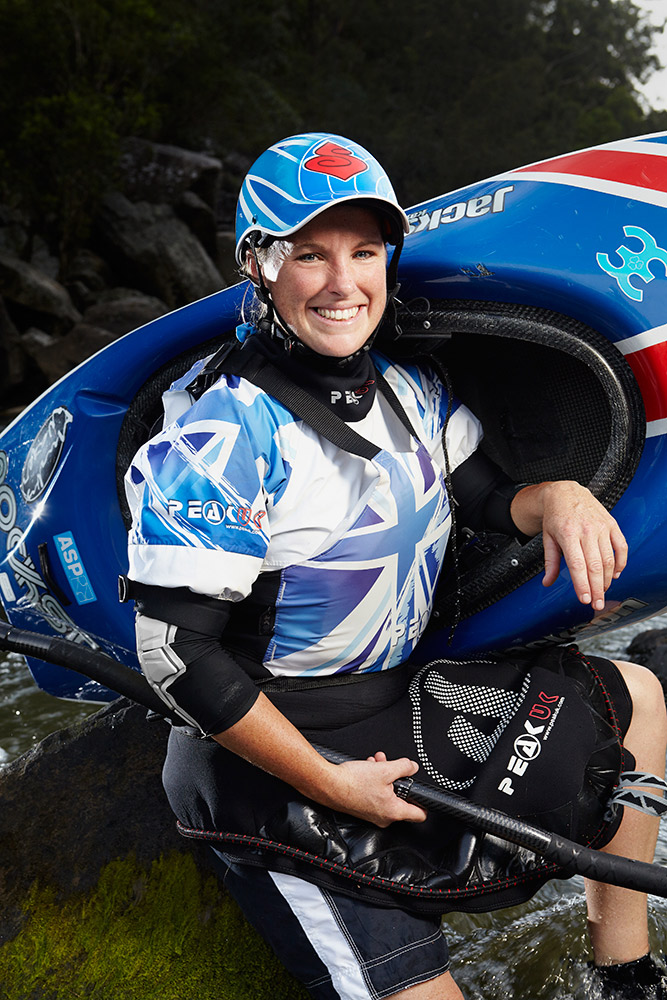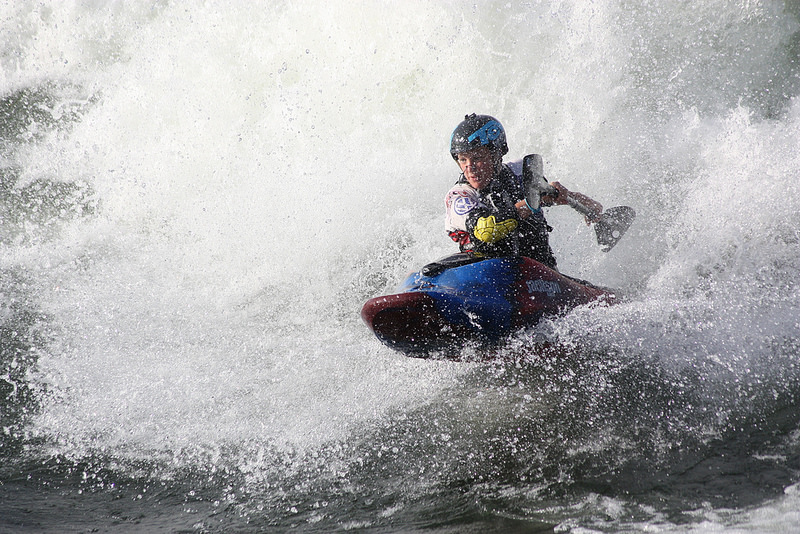
Claire O’Hara is two times world freestyle kayak champion and three times world champion squirt boat kayak. She is in conversation with Namita Nayyar President Women Fitness.
Ms. Namita Nayyar:
You started kayaking when you were about 15 years old with Leeds Canoe Club in 1996. Whilst at Leeds Metropolitan University you were the captain of the Leeds Met University Kayak club. At Leeds Met University you were awarded a Carnegie Sports Scholarship in 2003 in recognition of your talent and dedication to the sport of kayaking. You reached the pinnacle of success when you won the World Championship in Freestyle Kayak and Squirt Boat Kayak and became the most successful female freestyle kayaker in the World. Tell us about your journey that took you to where you are now in the world of kayaking and as a multi-disciplined paddler?
Ms. Claire O’Hara:
My journey started many years ago when I first went on a canoeing holiday with my mum and sister down the River Wye. It was here that I feel in love with the freedom of adventure out on the river and the technical challenge of the sport. On this trip I paddled a tandem canoe for 5 days but yearned to be in a kayak on my own like our instructor.
Following on from here I took every chance I could to get out on the water mostly during the summer holidays at activity camps. Then in 1996 my mum heard about our local kayak club and that was it my journey began. Initially I started off in the pool and on the local canal developing my basic fundamental skills. Quickly I progressed onto the rivers. A group of more experienced paddlers took me under their wing and mentored and guided me.
Within just a matter of months I was paddling technical grade 3/4 runs. The club was a recreational whitewater club and had paddlers within it that took part in many different elements of the sport which was fantastic as it allowed me to experience a vast diversity of elements of paddler sports. We would enter canoe rally’s, multi day canoeing self support journeys, slalom races, whitewater kayak festivals and gatherings, canoe polo tournaments as well as many club trips most of which involved heading to the ocean to kayak surf or heading to the rivers to tackle the Rapids, across the UK and further afield. My first international trips taking me to the big water rivers of Austria Alps and then the Himalayas in Nepal.
After I’d been paddling for 5 years and during my time at university a number of my friends started paddling at the local freestyle kayaking events (Peak Challenges) and in 2001 I went along with them to my first event. The excitement and energy around the event had me instantly hooked. Here was a super supportive, friendly and fun new discipline of the sport. The lads were already really good and set a high standard from the start for me to chase. Initially it started out as just another fun discipline of paddle sport. However the more I did it the more addicted I got. In 2004 I won my first big event the National Student Rodeo in my final year at University. Then in 2005 I went for GB team trials and won a place on the team for the 2006 European Championships. This was my first of many major international events.
It was around this point that I found my real focus within the sport. Even now I still run rivers and love jumping into any type of paddling craft but I have a real passion and drive for freestyle and within that the specialist disciplines of freestyle kayak and squirt.
In 2009 I won my first World Championship Gold medal and have remained at the top of the sport ever since. I now hold 7 World titles and have set many new standards and records for female paddle sport. I love whitewater kayaking and freestyle and continue to travel, train, paddle, coach and compete around the world full time. My next big event is the 2015 ICF World Championships that I will be competing in this summer on the Ottawa river in Canada.
Ms. Namita Nayyar:
You have selected a sports as a multi-disciplined paddler and have experience in paddling freestyle, squirt boat, slalom, surf, polo and white water kayak that requires a lot of hard labor, technical soundness and excellence in different faculties to finally succeed, how do you achieve that?

Ms. Claire O’Hara:
I think have been able to achieve the success and diversity in my paddling as a result of the many incredible opportunities that have come my way during my paddling life. I am the kind of person who says yes and try’s to maximize on every opportunity that comes my way and I think that as a result of this I have been able to experience and develop wider both as a paddler and a person. I enjoy challenge and trying new things especially within the sport I love.
I enjoy and thrive of the challenge of learning difficult skills and often won’t stop trying until I master it. Something I think is especially essential in learning freestyle kayaking skills and I think has helped me achieve the high standards that I have. If I can see someone else can do something and I want it. I will keep working and trying until I figure it out. I think that this determination and drive and passion for excellence combined with the transferability of a lot of the paddle sport skills has meant that I have been able to experience and enjoy many of the incredible disciplines of kayaking over the years. Something I look forward to continuing to a lot more in future years.
I thrive on being the best I possibly can and I am extremely competitive. Add this to a sport where there is always more to learn, new rivers and waves to paddle and new skills to master, and you are on a never ending learning curve.
Ms. Namita Nayyar:
How could you overcome the element of fear in freestyle kayaking as a sport?
Ms. Claire O’Hara:
Fear is something that challenge us all in many different ways through life. I see fear as being a way to describe the feelings associated with the hazards and risks involved in a situation. To me there are two components of fear that I have battled at different times during my paddling life. The battle with the Real ‘physical’ fear and the perceived ‘psychological’ fear.
In terms of real physical fear, I feel that this component of fear is associated with the direct dangers and life threatening risks that come from playing in a natural playgrounds and pushing the limits in a sport like this. This is something that I have become more and more aware of as I have progressed in my paddling career. The risk that comes from pushing the limits of an extreme sport and the increase in consequences that come with this.
To me a lot of my paddling nowadays has been shaped and developed by a real awareness of these risks. I have a real and very healthy respect for the rivers and the sport of kayaking and have chosen my current focuses within the sport as a result of this. My shift towards freestyle kayaking was partially due to the fact that freestyle, as a whole, is low risk. For a whitewater paddle sport, freestyle is extremely challenging and rewarding with endless opportunities for progression without the need to put yourself into increasing levels of danger as is more the case when searching for the same challenge and buzz out on the rivers.
So part of my fear coping strategy has been shaped by the disciplines I have chosen to focus on, as well as the ability to reflect on my previous experiences and acknowledge and respect the dangers and risk associated with the disciplines and different environments involved in my sport and make smart choices as a result of this.
The other fear I have and will continue to experience is the perceived (physiological) fear. The fear in your mind where the consequences of a situation are massive but the reality is the real physical risk is only small. To me this often relates to the nerves and expectations that i put upon myself as a competitor to achieve and reach a certain level of success.
This is something I am continually aware of and working to overcome. I find one of the biggest challenges here is to keep a realistic check on what my goals and outcomes are to ensure that they are controllable and realistic. For example at the 2015 World Championships if my goal is solely ‘to win both golds again’ then it carries with it a lot of pressure and a fear of not winning. Especially as Its in a situation that I cannot fully control, as I do not know and can not have any influence on what my competitors do or what the wave will be like on the day.
However if I change my goal slightly to be ‘to get as good as I possibly can’ by then. So I can ‘lay down the best possible rides I can on the day’ then suddenly the pressure is different. It becomes a much more manageable and controllable situation and therefore the fear is less as this is something that is much easier to achieve and ultimately if all goes well the outcome can be the same. If I can perform my best possible rides on the day and I prepare well, then in theory I am in with a very good shot of defending my World titles and winning both golds again.
These are both areas my coaches help me with a lot.
Video
Disclaimer
The Content is not intended to be a substitute for professional medical advice, diagnosis, or treatment. Always seek the advice of your physician or other qualified health provider with any questions you may have regarding a medical condition.